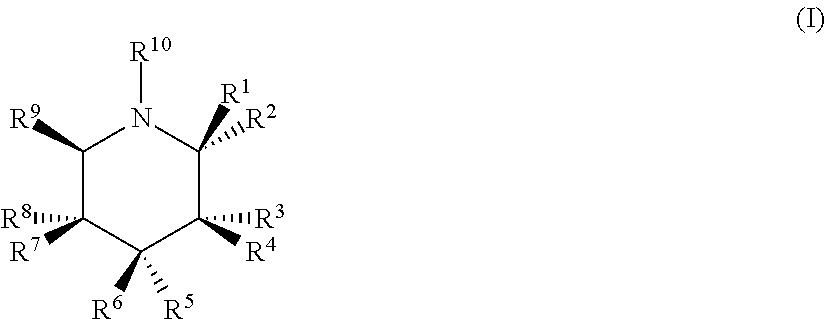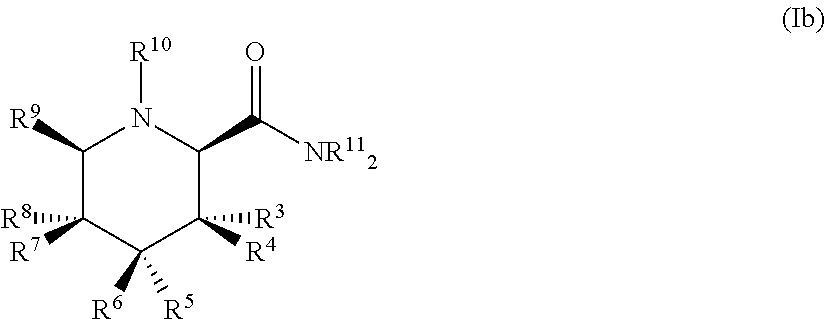Glycosidase inhibitors and uses thereof
- Summary
- Abstract
- Description
- Claims
- Application Information
AI Technical Summary
Benefits of technology
Problems solved by technology
Method used
Image
Examples
example 1
(2S,3R,4S,5R,6R)-3,4,5-trihydroxy-6-(hydroxymethyl)-N,1-dimethylpiperidine-2-carboxamide hydrochloride
[0226]
[0227]To a suspension of D-mannose (100.0 g, 0.56 mol) in dry acetone (2.2 L) was added iodine (28.6 g, 0.11 mol). The resulting mixture was stirred for 16 hours at ambient temperature to give a homogeneous solution. The reaction was then quenched by the addition of water (2 L) and neutralized by the addition of sodium bicarbonate (15 g, 0.18 mol). The resulting mixture was extracted with EtOAc (3×1 L). The combined organic layers was washed with brine (2×500 mL) and saturated aqueous solution of sodium sulfite (3×200 mL). After dried over anhydrous sodium sulfate, a filtration was performed and the filtrate was concentrated under reduced pressure to give (3aS,6R,6aS)-6-((S)-2,2-dimethyl-1,3-dioxolan-4-yl)-2,2-dimethyl-tetrahydrofuro[3,4-d][1,3]dioxol-4-ol as a colorless solid (130 g, 90%): 1H NMR (300 MHz, CDCl3) 65.38-5.01 (m, 0.2H), 4.83-4.80 (dd, J=3.6 Hz, 6.0 Hz, 0.8H), 4...
example 2
(2S,3R,4S,5R,6R)-1-((E)-3-([1,r-biphenyl]-4-yl)allyl)-3,4,5-trihydroxy-6-(hydroxymethyl)-N-methylpiperidine-2-carboxamide
[0238]
[0239]A solution of (3 aR,4S,6R,7R,7aS)-6-((tert-butyldimethylsilyloxy)methyl)-7-hydroxy-N,2,2-trimethyl-hexahydro-[1,3]dioxolo[4,5-c]pyridine-4-carboxamide (150 mg, 0.40 mmol) in MeOH (3 mL) was treated with 1 M hydrochloride solution in MeOH (1 mL) for 2 hours at ambient temperature. The reaction was diluted with water (20 mL) and the resulting solution was extracted with EtOAc (2×10 mL). The aqueous layer was treated by freeze drying to give (2S,3R,4S,5R,6R)-3,4,5-trihydroxy-6-(hydroxymethyl)-N-methylpiperidine-2-carboxamide hydrochloride as a colorless solid (100 mg, 97%): 1H NMR (400 MHz, D2O) δ 4.30-4.28 (m, 1H), 4.19 (d, J=4.0 Hz, 1H), 3.90-3.80 (m, 3H), 3.69-3.60 (m, 2H), 2.68 (s, 3H); MS (ESI, m / z): 221.0 [M+1-HCl]+.
[0240]To a solution of 1-bromo-4-phenylbenzene (10 g, 42.9 mmol) in DMF (150 mL) was added ethyl acrylate (8.6 g, 85.8 mmol) followed b...
example 3
(2S,3R,4S,5R,6R)-1-(3-([1,1′-biphenyl]-4-yl)propyl)-3,4,5-trihydroxy-6-(hydroxymethyl)-N-methylpiperidine-2-carboxamide
[0244]
[0245]To a stirred solution of (2S,3R,4S,5R,6R)-3,4,5-trihydroxy-6-(hydroxymethyl)-N-methyl-1-[(2E)-3-(4-phenylphenyl)prop-2-en-1-yl]piperidine-2-carboxamide (60 mg, 0.15 mmol) in MeOH (20 mL) was added palladium on charcoal (20 mg, 10% w / w). The resulting mixture was kept under a hydrogen atmosphere (1 atm.) for 4 hours at ambient temperature. Then, the mixture was filtered through Celite and the filtrate was concentrated under reduced pressure. The residue was purified by silica gel column chromatography, eluted with 2% to 10% MeOH in DCM to give (2S,3R,4S,5R,6R)-3,4,5-trihydroxy-6-(hydroxymethyl)-N-methyl-1-[3-(4-phenylphenyl)propyl]piperidine-2-carboxamide as a colorless solid (27.1 mg, 45%): 1H NMR (300 MHz, CD3OD) δ 7.54 (d, J=7.2 Hz, 2H), 7.47 (d, J=8.1 Hz, 2H), 7.37 (t, J=7.2 Hz, 2H), 7.22-7.28 (m, 3H), 4.17 (t, J=4.5 Hz, 1H), 3.90-3.87 (m, 1H), 3.81-3...
PUM
| Property | Measurement | Unit |
|---|---|---|
| Electrical conductance | aaaaa | aaaaa |
| Stress optical coefficient | aaaaa | aaaaa |
Abstract
Description
Claims
Application Information
 Login to View More
Login to View More - Generate Ideas
- Intellectual Property
- Life Sciences
- Materials
- Tech Scout
- Unparalleled Data Quality
- Higher Quality Content
- 60% Fewer Hallucinations
Browse by: Latest US Patents, China's latest patents, Technical Efficacy Thesaurus, Application Domain, Technology Topic, Popular Technical Reports.
© 2025 PatSnap. All rights reserved.Legal|Privacy policy|Modern Slavery Act Transparency Statement|Sitemap|About US| Contact US: help@patsnap.com



